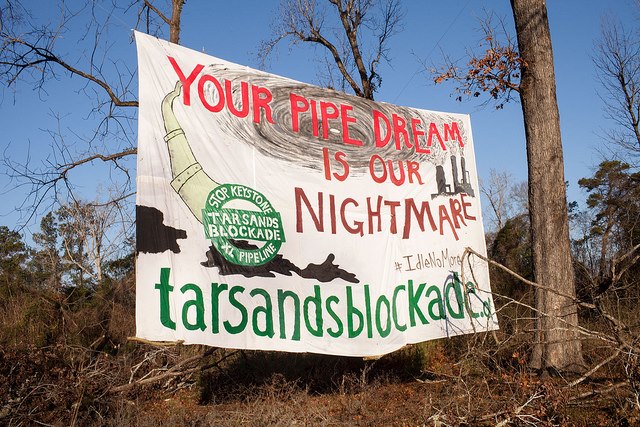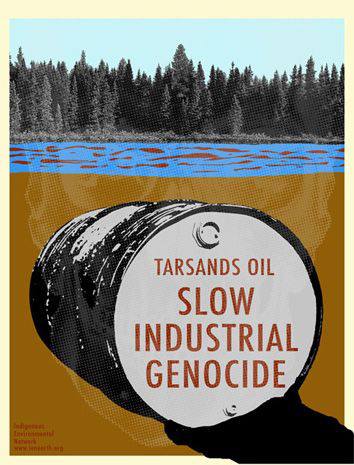The tar sands, a massive deposit of crude oil in Canada, has become a battleground for Native American Indians who are fighting to protect their land, which is threatened by the massive development projects. For centuries, Native American Indians have viewed the land as sacred, and it is at the center of their culture, spirituality, and identity. Now, as the tar sands development threatens their way of life, they have become a fierce resistance movement that is bringing together indigenous communities and environmental activists from all over the world. This article explores the impact of tar sands development on Native American Indian communities, the history of their resistance, and the challenges they face today.
Introduction to the Tar Sands and its Impact on Native American Indians
The tar sands, also known as oil sands, are a type of unconventional oil deposit that are primarily found in the boreal forests of Canada. Extraction of this oil is an incredibly destructive process that requires vast amounts of natural resources and energy. This has a devastating impact on local ecosystems and indigenous communities, in particular the Native American Indians. The development of tar sands has led to significant land dispossession, environmental destruction, and health and safety risks for Native American Indian communities across North America.
Overview of the Tar Sands and its Development
The tar sands contain a massive reserve of oil, estimated to be over 170 billion barrels, making it one of the largest reserves of oil in the world. The process of extracting this oil is incredibly energy-intensive and polluting. The tar sands are strip-mined or extracted using steam-assisted gravity drainage methods, which require huge amounts of water and heat. This process not only destroys vast areas of land, but also consumes a tremendous amount of water, which is often taken from local rivers and used in the extraction process.
Background on Native American Indians and their Land
Native American Indians have a deep connection to the land and the environment, and have lived in harmony with nature for thousands of years. Their traditional territories and sacred sites have been targeted by companies seeking to extract tar sands and other natural resources. Indigenous communities in the United States, Canada, and Mexico have been systematically displaced, marginalized, and often forced to relocate due to tar sands development, which has led to a loss of cultural identity and spiritual connection to the land.
The Historical and Cultural Significance of Land to Native American Indians
The Role of Land in Native American Indian Culture and Spirituality
Land plays a vital role in the culture, spirituality, and identity of Native American Indians. The land is not seen as a commodity or a resource, but as a sacred entity that must be respected and protected. Many Native American Indian communities view their relationship with the land as reciprocal, with humans being responsible for its protection and stewardship, and the land providing for their needs.
The History of Land Dispossession and Colonization of Native American Indian Lands
The history of Native American Indian land dispossession and colonization dates back to the arrival of European settlers in North America. Land was taken through forced removals, broken treaties, and violent conflicts. The U.S. government’s policy of Indian removal, in particular, resulted in the forced relocation of entire communities, leading to loss of land, culture, and identity. The legacy of this history continues to impact Native American Indian communities today, with the development of tar sands and other extractive industries threatening their remaining lands and resources.
Native American Indians’ Resistance to the Tar Sands Development
Indigenous-led Movements and Organizations Fighting Against Tar Sands Development
Indigenous-led movements and organizations have been at the forefront of resistance against tar sands development. Groups such as Idle No More and the Indigenous Environmental Network have been instrumental in raising awareness about the impacts of tar sands on Native American Indian communities and organizing resistance against development. These groups have also worked to build alliances with other environmental and social justice organizations.
Direct Action and Civil Disobedience Tactics Used by Native American Indians in Tar Sands Resistance
Native American Indians have also used direct action and civil disobedience tactics to resist tar sands development. From blockading pipelines to occupying extraction sites, these tactics have been effective in drawing attention to the issue and disrupting operations. However, these actions have also led to aggressive responses from law enforcement and government officials, who have been known to use violence and repression against activists.
The Environmental Impact of Tar Sands Development on Native American Indians
The Health and Environmental Risks of Tar Sands Development on Native American Indian Communities
The development of tar sands has had a devastating impact on the health and wellbeing of Native American Indian communities. The extraction process produces toxic waste and pollutants, including heavy metals, benzene, and carbon monoxide, which have been found to cause cancer, birth defects, and other health problems. The erosion of land and water loss caused by tar sands development has also impacted traditional subsistence practices of Native American Indians.
The Impact of Tar Sands Development on Wildlife and Ecosystems in Native American Indian Lands
The development of tar sands has also had a significant impact on wildlife and ecosystems in Native American Indian lands. The destruction of natural habitats has resulted in the decline of species such as woodland caribou, fish, and migratory birds. The extraction process also requires the use of large amounts of water, which has led to the loss of wetlands and other critical habitats. These impacts have had a ripple effect on the entire ecosystem, threatening the health and wellbeing of Native American Indian communities who depend on the land for their survival.
Legal Battles and Political Campaigns to Stop the Tar Sands Development
Native American Indian communities have been at the forefront of the fight against tar sands development in North America. They have used legal battles and political campaigns to stop the construction of pipelines on their lands, which would transport tar sands crude oil from Canada to the United States.
The Role of International Human Rights Law in Protecting Native American Indian Rights
Native American Indian communities have been able to use international human rights law to support their resistance against tar sands development. The United Nations Declaration on the Rights of Indigenous Peoples recognizes their rights to self-determination, free, prior and informed consent, and the protection of their cultural, economic and social rights. These rights have been used in legal battles against the construction of pipelines on their lands.
Political Mobilization and Lobbying Efforts to Halt Tar Sands Development on Native American Indian Lands
Native American Indian communities have also engaged in political mobilization and lobbying efforts to halt tar sands development on their lands. They have formed alliances with other indigenous communities and environmental and social justice organizations to push for policy change at the state and federal levels. They have also engaged in direct actions to stop the construction of pipelines and other infrastructure projects.
The Role of Allies in the Fight Against Tar Sands Development
Native American Indian communities have recognized the importance of building coalitions and strategic alliances with non-indigenous groups in the fight against tar sands development.
The Importance of Building Coalitions and Strategic Alliances with Non-Indigenous Groups
Allies provide important resources, such as funding, legal expertise, and media coverage to support Native American Indian resistance to tar sands development. They also help to amplify their voices and demands in the public sphere.
The Role of Environmental and Social Justice Movements in Supporting Native American Indian Resistance to Tar Sands Development
Environmental and social justice movements have been instrumental in supporting Native American Indian resistance to tar sands development. They have recognized the impact that tar sands development has on the environment, public health, and social justice, and have stood in solidarity with Native American Indian communities to oppose it.
Challenges and Future Prospects for Native American Indians in the Tar Sands Resistance
Despite their efforts, Native American Indian communities continue to face challenges in their resistance to tar sands development.
Continuing Challenges and Obstacles Faced by Native American Indians in the Tar Sands Resistance
They face legal barriers and government opposition to their claims to sovereignty and self-determination. They also struggle with limited resources and access to political power, which impedes their ability to effectively resist tar sands development.
The Future of Native American Indian Sovereignty and Activism in Protecting their Lands and Rights
The future of Native American Indian sovereignty and activism in protecting their lands and rights remains uncertain. However, their continued resistance and the growing support from allies and environmental and social justice movements offer hope for a more just and sustainable future.
Conclusion and Call to Action for the Protection of Native American Indian Land and Rights
The fight against tar sands development on Native American Indian lands is a fight for justice, human rights, and environmental protection. The protection of their lands and rights is essential for the well-being of their communities, as well as for global efforts to address climate change and promote sustainability.
The Need for Continued Support and Solidarity with Native American Indian Communities in the Fight Against Tar Sands Development
We must continue to support and stand in solidarity with Native American Indian communities in their resistance to tar sands development. This includes providing financial resources, amplifying their voices and demands, pushing for policy change, and engaging in direct actions to halt the construction of pipelines and other infrastructure projects on their lands. Let us join together to protect Native American Indian lands and rights for generations to come.In conclusion, the fight against tar sands development is an urgent matter for Native American Indians and their allies. The struggle to protect the land is not just about the environment, but it is also about indigenous sovereignty, human rights, and justice. It is a fight that has been going on for generations, and it will continue for generations to come. We must stand in solidarity with Native American Indian communities and support their struggle for the protection of their land and rights. We must do everything in our power to halt the tar sands development and promote a sustainable, just, and equitable future for all.
Frequently Asked Questions (FAQ)
What are tar sands, and why are they a problem?
Tar sands are a mixture of sand, clay, water, and a thick, molasses-like substance called bitumen. The extraction of bitumen from tar sands requires massive amounts of energy and water, which leads to environmental destruction and greenhouse gas emissions. The tar sands are the largest industrial project in human history and have been called “the most environmentally destructive project on earth.”
What is the impact of tar sands development on Native American Indian communities?
Tar sands development has devastating impacts on Native American Indian communities, who rely on the land for their subsistence, culture, and spirituality. The development of tar sands leads to the destruction of forests, wetlands, and wildlife habitats, contaminates the air and water with toxic pollutants, and poses significant health risks to indigenous peoples living downstream from the tar sands operations.
What is the role of allies in the fight against tar sands development?
Allies play a critical role in supporting the fight against tar sands development by showing solidarity with Native American Indian communities, amplifying their voices, and providing financial and legal support. By building bridges with environmental and social justice movements, allies can create a powerful coalition that can put pressure on governments and corporations to halt the tar sands development.
What can I do to help protect Native American Indian lands and rights?
There are many things individuals can do to support Native American Indian communities in their struggle against tar sands development. Some actions include: educating oneself about the issue, supporting indigenous-led campaigns and organizations, divesting from fossil fuels and supporting renewable energy, boycotting companies involved in the tar sands development, and pressuring elected officials to take action. It is important to remember that the fight against tar sands development is a long-term struggle, and every action can make a difference.



davidsuzuki - It will take more than rebranding to make tar sands oil "ethical"
http://tarsandsaction.org/



